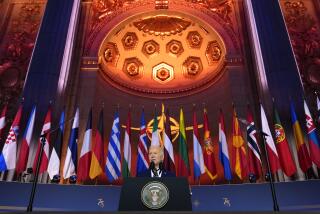NATO Tries to End Deadlock on Troop Cuts
VIENNA — In a major concession aimed at breaking a 12-year stalemate, the North Atlantic Treaty Organization formally offered a new proposal Thursday for modest cuts in Soviet and American troop levels in Central Europe.
About 11,500 Soviet troops and 5,000 U.S. troops would be withdrawn from Central Europe under the NATO proposal, followed by a three-year freeze on troop levels. The withdrawals would be subject to verification and on-site inspections.
At the mutual and balanced force reduction talks here, NATO dropped its long-held position that there could be no reduction in conventional forces until it agreed with the Warsaw Pact on exactly how many men are now under arms on each side. This demand for more data on Soviet Bloc forces has effectively blocked all progress here almost since these talks began in 1973.
NATO intelligence estimates put the current size of forces in Eastern Europe at 190,000 to 230,000 more than the figure acknowledged by the Warsaw Pact nations.
In the last official exchange of figures in 1980, the Warsaw Pact said it had 980,000 troops, both ground and air, stationed in Europe. NATO claimed then that the Warsaw Pact had 1,190,000 troops, while placing its own force level at 990,000.
The proposal to shelve the data question had been under study by the NATO powers for more than six months, with the British and the West Germans taking the lead against what sources here described as “strong opposition” from the Pentagon.
President Reagan decided to alter the U.S. position just before the superpower summit at Geneva, where he and Soviet leader Mikhail S. Gorbachev jointly pledged their “willingness to work for positive results” in the Vienna negotiations.
Summit Triggered Decision
That declaration triggered the final decision within NATO to offer the new proposal on the closing day of the current round of the force-reduction talks--the 413rd plenary session since 1973.
“President Reagan has said that it will be deeds and not words that show whether the Geneva summit was a true success, and today in Vienna what has happened is a deed,” said Ambassador Robert Blackwill, head of the U.S. delegation.
Initial Soviet reaction here, however, was decidedly sour. Ambassador Valerian V. Mikhailov offered the standard diplomatic assurance that the new Western proposal “naturally would be carefully studied,” but he said it was “filled with a dubious content” and “does not give cause for optimism.”
The Soviets objected to the omission of armaments reductions from the NATO proposal as well as the provision for what the Soviet ambassador called “excessively inflated” verification measures.
Lack of Instructions
Senior NATO diplomats said they had the impression that although the Soviets were handed the proposals on Tuesday, two days before their formal presentation, there had not yet been any clear instructions from Moscow on a response.
As one diplomat put it: “What we have gotten is a typical Soviet holding operation, and we won’t really know how they will play this one until we come back here at the end of January, by which time Gorbachev will have taken a look at it.”
Nevertheless, after many months on the defensive in these talks, the NATO powers have suddenly turned the tables and seized the initiative.
Four ambassadors, from the United States, Britain, West Germany and the Netherlands, appeared at a joint news conference to announce the new initiative in the biggest public relations blitz from the NATO side in the long and turgid history of these talks.
“If the Eastern Bloc countries mean what they say about their concern for the peace and security of Europe, we will now go forward and negotiate an agreement here,” said British Ambassador Michael Alexander, who made the formal presentation at the plenary meeting on behalf of the NATO powers. “We have accepted their basic framework for a negotiation, and we hope that there will be no more suggestions from the East that we are blocking the way forward.”
No Quick Solution
However, there certainly will not be any quick solution or early accord in Vienna. Agreement with the Soviets on verification measures and the monitoring of troop reductions and force levels will almost certainly replace the data question as the roadblock.
These are the major elements of the NATO proposal:
--A token reduction of 11,500 Soviet troops (about one infantry division) and 5,000 U.S. troops (about an infantry brigade) for a trial period of three years, to see whether an agreement can be made to work.
--A simultaneous agreement between East and West not to increase total ground and air forces on each side. This does not mean, however, that national force levels could not be adjusted within the total. If Belgium goes down, for example, West Germany might go up.
--A Soviet proposal for a simultaneous freeze on armaments along with manpower is rejected by the NATO powers under the new plan as unworkable--although this would be left open for future negotiation if the trial run of token troop reductions works out satisfactorily.
--Verification measures to include not only “national intelligence means”--such as satellite and air reconnaissance--but also a minimum of 30 on-site inspections of each other’s forces annually during the three-year agreement.
--An exchange of detailed information between the two sides on the order of battle of existing forces down to battalion level. The on-site inspections would then be used to verify these battalion strengths.
--Ninety percent of the withdrawal of Soviet and American forces would be accomplished by reducing unit strength and 10% by scattered manpower reductions. The units would withdraw from the central front through checkpoints manned by both sides and would return to their national territories. The U.S. forces would come out of West Germany, and the Soviet division could be withdrawn from East Germany, Czechoslovakia or Poland.
More to Read
Sign up for Essential California
The most important California stories and recommendations in your inbox every morning.
You may occasionally receive promotional content from the Los Angeles Times.










